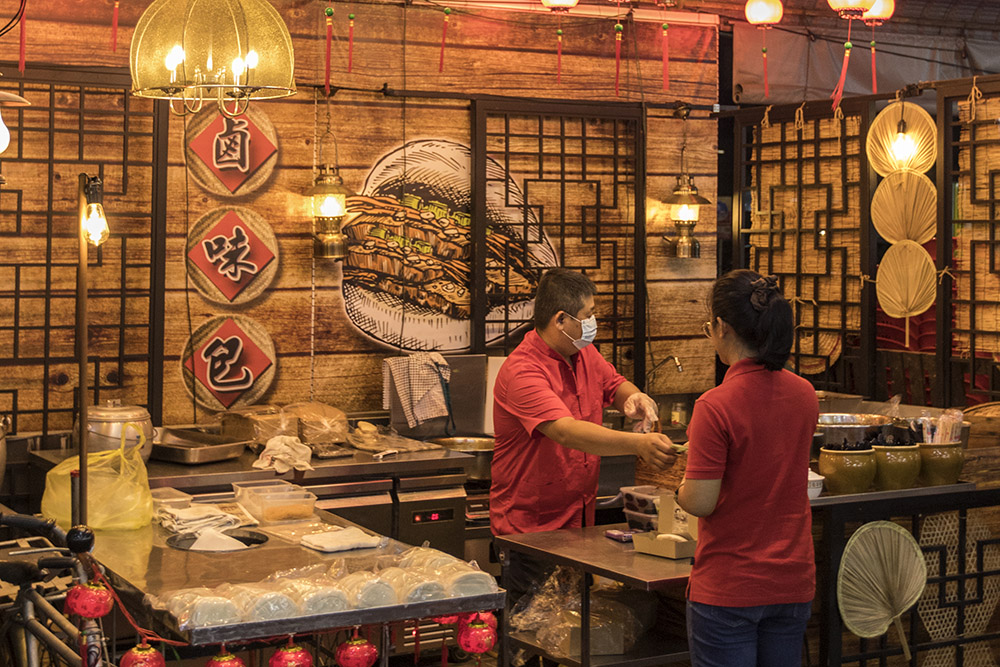IPOH, Oct 13 — It’s a simple thing, or looks that way.
A signature of David Chang’s Momofuku Noodle Bar, the pork buns are really just that: steamed bao split down the middle, roasted pork belly, a smear of hoisin sauce, finely sliced scallions and quick-cured cucumbers. A squirt of Sriracha at the table, maybe.
That’s all. Yet this iconic dish of the Momofuku empire has been replicated a hundred times over around the world, from fine dining restaurants to night market stalls.
There is something deceptively alluring about a fatty slab of pork wedged inside a hot steamed bun. The dish itself is inspired by humble Taiwanese street fare so perhaps that’s what calls out to us: a taste of comfort and convenience.
So yes, there have been countless variations of the steamed pork bao but perhaps the most satisfying version I’ve had in a long time can be found in Ipoh, in a food court no less.

Restoran Kam Wan Aneka Selera in Ipoh’s Taman Canning is one of those old-school food courts where nearly every stall — almost 50 of them! — focuses on a different type of hawker favourite.
Ikan bakar and tomyam meehoon. Char kway teow and nasi pandan. Fried mantis prawns and oyster sauce crabs. Hakka lei cha and fried radish cake. The list of what we can devour seems endless.
This is where the locals actually eat. The choices alone can boggle the mind. Do we have fruit rojak first or a bowl of refreshing wan tau long, the tart yellow jelly wobbling on a mound of freshly-shaved ice?
The answer, for us, is easy: we head to the Kampung Lu Rou stall. Here you may select all manner of braised meats as filling for their bao buns, hot and fresh from the steamer.

Try the basic ru rou (braised minced pork) or the ru ya (braised duck); there’s even pork floss. Don’t fancy meat? You have a choice of red bean, pandan and pandan lotus fillings too.
But my favourite is their ru dong bo rou bao or braised pork belly in a steamed bun: the savoury gravy from long braising; the melt-in-your-mouth meat, full of flavourful fat; and a soft, pillowy bun to soak it all up.
It’s love at first bite, and then the second, and then it’s gone and you make a beeline to queue up to order more... Who needs Momofuku?
Another popular stall is Bibi Popiah; our friend, an Ipoh boy, claims they make the best popiah in town. That’s a huge assertion but we’re happy to put it to the test.

He suggests that we go for Bibi’s signature or original popiah. The standard filling of finely julienned yam bean and carrots is elevated with crunchy bits of deep fried garlic and shallots. What a textural contrast!
Besides the original flavour, you may enjoy the popiah with seaweed, shrimps or deep fried until golden brown and super crispy. Bibi also offers chicken rendang with three flavours of popiah skin — original, cabbage and black glutinous rice.
You may sit wherever you like but we make a strategic move to grab a table near a “twin stall” — the one on the left sells rojak, blanched kerang (cockles) and sotong kangkung; the one on the right serves curry mee and lam mee.
It’s a two-for-one location though our friend tells us we’d have to pay separately at each half of the stall depending on what we order. Clearly a food court quirk but that’s just one more thing to love about this very Malaysian way of dining.

A must-order is the sotong kangkung — blanched cuttlefish and water spinach nearly entirely hidden under a thick, unctuous gravy. Our friend informs us that “most places use prawn sauce or har gou but here in Perak, we use satay sauce or a peanut and curry sauce.”
To each their own but we certainly can’t argue with the results: fresh and crunchy, aromatic and piquant. Their curry mee is another highlight: rich and creamy, with a hidden treasure trove of blood cockles for those who insist on their see hum.
Speaking of treasures, our friend recommends we try a local drink: the “Eight Treasures” (bat bo) with lemon and a dash of Eno! How did this beverage come about? One must assume it’s a cure for all the food court binging one can’t help but indulge in.

Certainly that’s the image the effervescent fruit salts conjure up though the minor delight in pouring a sachet of the stuff into the herbal drink and seeing it bubble right up might be closer to the real reason for its invention.
Let’s just say it’s an acquired taste for out-of-towners. At the very least, we get a dose of antacid — which means we can go for another round of eating!
And if I’m being honest, I wouldn’t mind another ru dong bo rou bao. It’s a simple thing, or looks that way. But looks can be deceiving for this simple bao has bowled me over.
Restoran Kam Wan Aneka Selera
85, Lengkok Canning, Taman Canning, Ipoh
Opens daily 1:30pm-10:30pm; business hours vary for different stalls
For more slice-of-life stories, visit lifeforbeginners.com.






















